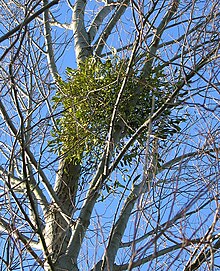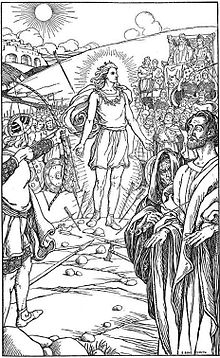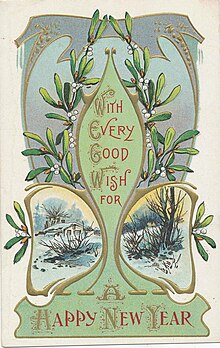Viscum album
| Viscum album | |
|---|---|

| |
| Viscum album growing on a Populus species | |
| Scientific classification | |
| Kingdom: | Plantae |
| Clade: | Tracheophytes |
| Clade: | Angiosperms |
| Clade: | Eudicots |
| Order: | Santalales |
| Family: | Santalaceae |
| Genus: | Viscum |
| Species: | V. album
|
| Binomial name | |
| Viscum album | |

Viscum album is a species of mistletoe in the family Santalaceae, commonly known as European mistletoe, common mistletoe or simply as mistletoe (Old English mistle).[2] It is native to Europe and western and southern Asia.[3]
Viscum album is a
Description
It is a
It is commonly found in the crowns of broad-leaved trees, particularly apple, lime (linden), hawthorn and poplar.[5]
European mistletoe is the only multicellular organism known to not have a functioning respiratory complex I in its electron transport chain, a protein that's essential for the creation of useful energy for its cells.[6] It is believed to survive by obtaining adenosine triphosphate and energy-rich compounds from its host as well as reorganizing its other respiratory complexes and slowing its growth and energy requirements.[7]
Classification
The mistletoe was one of the many species originally described by Linnaeus. Its species name is the Latin adjective albus "white". It and the other members of the genus Viscum were originally classified in the mistletoe family Viscaceae, but this family has since been sunk into the larger family Santalaceae.
Subspecies
Several subspecies are commonly accepted.[8][9][10][11] They differ in fruit colour, leaf shape and size, and most obviously in the host trees utilised.
- Viscum album subsp. abietis (Wiesb.) Abromeit. Central Europe. Fruit white; leaves up to 8 centimetres (3.1 in). On Abies.
- Viscum album subsp. album. Europe, .
- Viscum album subsp. austriacum (Wiesb.) Vollmann. Fruit yellow; leaves 2–4 centimetres (0.79–1.57 in). Central Europe. On Larix, Pinus, Picea.
- Viscum album subsp. meridianum (Danser) D.G.Long. Southeast Asia. Fruit yellow; leaves 3–5 centimetres (1.2–2.0 in). On Acer, Carpinus, Juglans, Prunus, Sorbus.
- Viscum album subsp. creticum has recently been described from eastern Pinus brutia.
- Viscum album subsp. coloratum Kom. is treated by the Flora of China[9] as a distinct species Viscum coloratum (Kom) Nakai.
Toxicity
European mistletoe is potentially fatal, in a concentrated form, and people can become seriously ill from eating the berries.[13]
The toxic
Some birds have immunity to the poison and enjoy the berries, especially the mistle thrush which is named for its favourite food.
Culture, folklore and mythology

European mistletoe features in many myths and legends from early written sources, into the modern period. In cultures across pre-Christian Europe, mistletoe was often seen as a representation of divine male essence (and thus romance, fertility and vitality).[16]
Ancient Greek and Roman
Mistletoe figured prominently in Greek mythology, and is believed to be the Golden Bough of Aeneas, ancestor of the Romans.[17] Also in Greek mythology mistletoe was used by heroes to access the underworld.[18] The Romans associated mistletoe with peace, love and understanding and hung it over doorways to protect the household.[19]
Celtic
Modern botanists believe the described Mistletoe species in oak trees was Loranthus europaeus.[citation needed]
Germanic

According to the 13th century Prose Edda, the goddess Frigg had everything swear an oath not to hurt her son Baldr, except for mistletoe, because "it seemed too young" to her for that. After this at the thing, other gods had fun by shooting at him, or hurling stones, without him being injured at all. Loki, wishing him dead, tricked Baldr's brother, the blind god Höðr into throwing mistletoe at Baldr, killing him.[20]
In the version of the story in Gesta Danorum, Baldr and Höðr are rival suitors for Nanna, and Höðr kills Baldr with a sword named Mistilteinn (Old Norse "mistletoe").[21] In addition, a sword by the same name also appears in Hervarar saga ok Heiðreks and Hrómundar saga Gripssonar.[22]
Christian

When Christianity became widespread in Europe after the 3rd century AD, the religious or mystical respect for the mistletoe plant was integrated to an extent into the new religion.[
Mistletoe is commonly used as a Christmas decoration, though such use was rarely alluded to until the 18th century.[24] According to custom, the mistletoe must not touch the ground between its cutting and its removal as the last of Christmas greens at Candlemas. It may remain hanging throughout the year, often to preserve the house from lightning or fire, until it is replaced the following Christmas Eve.[24][25] The tradition has spread throughout the English-speaking world, but is largely unknown in the rest of Europe. (The similar native species Phoradendron leucarpum is used in North America in lieu of the European Viscum album.)
According to an old Christmas custom, a man and a woman who meet under a hanging of mistletoe were obliged to kiss. The custom may be of Scandinavian origin.[26] It was alluded to as common practice in 1808[27] and described in 1820 by American author Washington Irving in his The Sketch Book of Geoffrey Crayon, Gent.:
The mistletoe is still hung up in farm-houses and kitchens at Christmas, and the young men have the privilege of kissing the girls under it, plucking each time a berry from the bush. When the berries are all plucked the privilege ceases.[28]
In Germany, the Christmas tradition is that people who kiss under mistletoe will have an enduring love or are bound to marry one another.[29]
Other
Every year, the UK town of Tenbury Wells holds a mistletoe festival and crowns a 'Mistletoe Queen'.[19]
Mistletoe is the county flower of Herefordshire. It was voted such in 2002 following a poll by the wild plant conservation charity Plantlife.[30]
Uses
Flavoring
Mistletoe is an ingredient of biska, a pomace brandy-based liquor made in Istria.[31]
Alternative medicine
Mistletoe leaves and young twigs are used by herbalists, and preparations made from them are popular in Europe, especially in Germany, for attempting to treat circulatory and respiratory system problems.[32][33][34] Use of mistletoe extract in the treatment of cancer originated with Rudolf Steiner, the founder of Anthroposophy.[35]
Although laboratory and animal experiments have suggested that mistletoe extract may affect the immune system and be able to kill some kinds of cancer cells, there is little evidence of its benefit to people with cancer.[36][37]
Bird trapping
The sticky juice of mistletoe berries was used to make
The Latin word viscum, 'mistletoe, birdlime' is the source of viscous.[39]
Gallery
-
19th century illustration by Franz Eugen Köhler
-
On an apple tree in Essex, England
-
In abundance on an apple tree (in Franche-Comté).
-
Sticky seed on a branch
-
InVersailles, France
-
Fruit of V. a. album, in Poland
-
V. a. austriacum onPinus sylvestris, Poland
-
Fruit, in Gryfino, NW Poland.
-
Viscum album in France, winter
-
Viscum album in Ukraine, spring
-
Cross section of wood
See also
References
- ^ Chappuis, E. (2014). "Viscum album (Europe assessment)". IUCN Red List of Threatened Species. 2014: e.T203473A2766017. Retrieved 11 October 2023.
- ISSN 0367-2530.
- PMID 26912113.
- ISSN 1916-2790.
- ^ Broadmeadow, Mark. "ISSUE 9 – Spring/Summer 2005". Tree News Magazine. Archived from the original on 2006-01-03.
- ^ "Mistletoe is missing the machinery to make energy". www.science.org. Retrieved 2022-02-08.
- S2CID 51956904.
- ^ "Flora Europaea Search Results = Viscum album". Royal Botanic Garden Edinburgh. Retrieved 2022-08-25.
- ^ a b "Viscum album Linnaeus subsp. meridianum". Flora of China @ efloras.org. Archived from the original on 2016-03-03.
- ISBN 0-7195-2428-8.
- OCLC 41355268.
- ISSN 0792-9978.
- ^ "Is mistletoe poisonous?". Poison Control.
- ^ PMID 7142144. Retrieved 2009-06-22.
- ^ PMID 7142145. Retrieved 2009-06-22.
- ^ Wikidata Q119858256
- ^ Virgil (19 BCE) The Aeneid
- ^ Bonham, Emma (2015-12-01). "Mistletoe: meaning, mythology and magic". woodlandtrust.org.uk. Archived from the original on 2018-12-09.
- ^ a b Bell, Bethan (2013-12-10). "Tenbury Wells: Centuries-old romance with mistletoe". BBC News.
- ISBN 0-460-87616-3.
- ISBN 978-0-85991-502-1.
- ISBN 9780859915137.
- ^ Graham, Winston (2002). "Chapter 6". Bella Poldark. Macmillan.
- ^ ISSN 0015-587X.
- ^ Peffley, Ellen (2013-12-25). "The history and not-so-romantic truth about mistletoe". Lubbock Avalanche-Journal.
- ^ E. Cobham Brewer, Dictionary of Phrase and Fable 1898, s.v. "Kissing under the mistletoe" relates the custom to the death of Baldr, without authority.
- ^ In a newspaper advertisement for shaving products:'THE KISS UNDER THE MISSELTOE. Under the misseltoe the maid was led/Altho' she cried, No, she held up her head/To obtain a kiss: a sigh was heard./The reason why - Tom rubbed her with his beard' The Times (London, England), 13 October 1808; p.4
- ^ Irving, Washington (1849). "Christmas Eve". The Sketch Book of Geoffrey Crayon, Gent. Works of Washington Irving. G. P. Putnam. p. 254.
- ^ "Warum küsst man sich unter dem Mistelzweig?". zeit.de (in German).
- ^ "Mistletoe". Plantlife.
- ^ Rushby, Kevin (20 August 2016). "Cres, Croatia: island of ghosts and vultures". The Guardian. Retrieved 27 December 2017.
- S2CID 46016570.
- ^ "Mistletoe". drugdigest.org. Archived from the original on 2008-07-19.
{{cite web}}: CS1 maint: unfit URL (link) - ^ "A Modern Herbal - Mistletoe". Botanical.com. Archived from the original on 2016-08-21.
- ^ "European and Oriental mistletoe: From mythology to contemporary integrative cancer care". sciencedirect.com.
- ^ "Questions and Answers About Mistletoe". National Cancer Institute. 24 March 2015. Retrieved 3 December 2015.
- PMID 18425885.
The review found that there was not enough evidence to reach clear conclusions about the effects on any of these outcomes and it is therefore not clear to what extent the application of mistletoe extracts translates into improved symptom control, enhanced tumour response or prolonged survival.
- ^ Johnson, T.B. (1848). The Sportsman's Cyclopaedia. Henry G. Bohn. p. 56.
- ^ Harper, Douglas. "viscous | Origin and meaning of viscous by Online Etymology Dictionary". www.etymonline.com. Retrieved 22 May 2021.
Further reading
- Tubeuf, Karl; Neckel, Gustav (1923). Monographie der Mistel. München und Berlin, Oldenbourg.
- Huxley, A., ed. (1992). New RHS Dictionary of Gardening. Vol. 4. p. 676. ISBN 0-333-47494-5.













